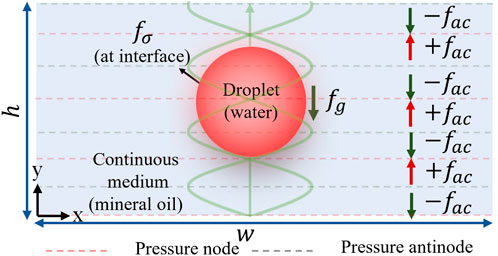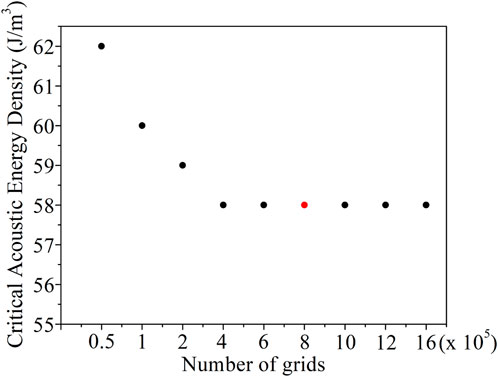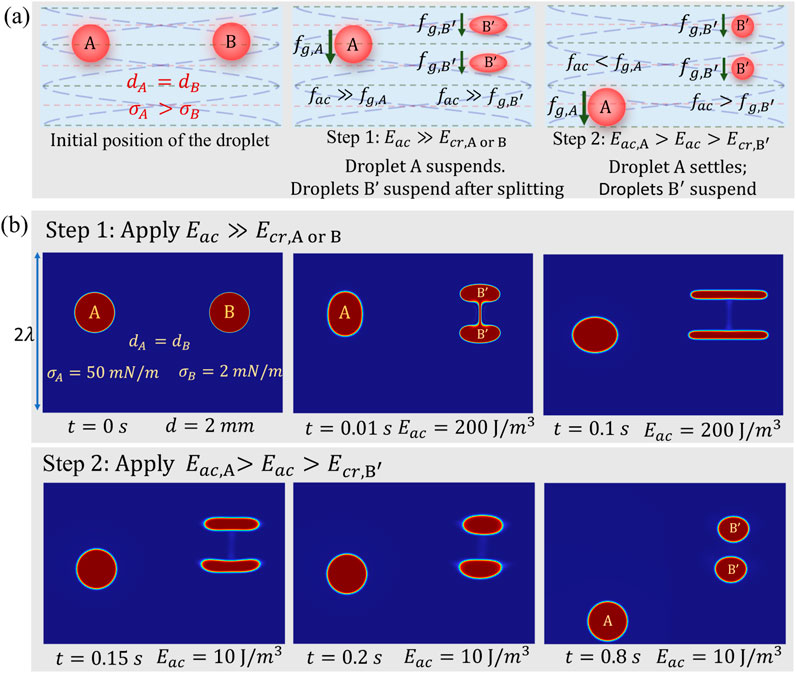
95% of researchers rate our articles as excellent or good
Learn more about the work of our research integrity team to safeguard the quality of each article we publish.
Find out more
ORIGINAL RESEARCH article
Front. Acoust. , 20 March 2025
Sec. Acoustofluidics
Volume 3 - 2025 | https://doi.org/10.3389/facou.2025.1544464
This article is part of the Research Topic Insights in Acoustofluidics: 2024 View all 3 articles
 Jeyapradhap Thirisangu
Jeyapradhap Thirisangu Karthick Subramani*
Karthick Subramani*The physics of droplets beyond the Rayleigh limit offers a novel acoustic sorting method that is fundamentally different from the techniques applied to sort droplets within the Rayleigh limit. Using this “acoustic sorting beyond Rayleigh limit” method, we theoretically demonstrate that by controlling the frequency
Acoustophoresis, the manipulation of matter using acoustic fields, has its foundations since the late 18th century (Chladni, 1787; Faraday, 1831; Kundt and Lehmann, 1874). Significant advancements in the theoretical understanding of the acoustic radiation force
where
The acoustic radiation force
Building on the theoretical understanding gained from our previous work (Thirisangu et al., 2024a), we present a novel acoustic sorting method for droplets beyond the Rayleigh limit, specifically focusing on selective sorting of droplets across a wide range of sizes, including intermediate sizes. By controlling the wavelength and acoustic energy density, we demonstrate the ability to suspend larger droplets while smaller ones settle, or vice versa. Additionally, we present the methodology for sorting intermediate-sized droplets from a broad size range. Using this method, we further show the ability to sort droplets of the same size but with differing interfacial tensions through droplet splitting. Unlike size-based sorting methods, our approach enables droplets of the selected size to remain suspended, while droplets of other sizes settle indefinitely until the critical acoustic force is applied.
When immiscible inhomogeneous fluid (water droplet in the mineral oil) is subjected to gravity and acoustic fields as shown in Figure 1, the dynamics is governed by the incompressible mass continuity, momentum conservation, and advection-diffusion equations (Landau and Lifshitz, 1987; Thirisangu et al., 2024a), which are given below,
where

Figure 1. A schematic representation of a droplet with a size beyond the Rayleigh limit (
Where
The numerical investigation of droplet behavior under acoustic fields is conducted by solving the governing equations simultaneously. These include the continuity equation (Equation 2a), the momentum equation (Equation 2b), and the advection-diffusion equation (Equation 2c), with the acoustic force equation (Equation 3) incorporated as a body force term. The simulations are performed using COMSOL Multiphysics 6.0, accounting for gravitational and interfacial forces within the computational framework. The interface of the droplet is modeled using phase field module, which are solved alongside the laminar flow equations. A time-dependent study is solved using the Implicit Backward Differentiation Formula. The flow field variables and the phase field variables are solved using the segregated Parallel Direct Solver. A two-dimensional channel with a width

Figure 2. Grid independence analysis: The figure shows the critical acoustic energy density
When an acoustic field is not present, a higher-density droplet (water) settles in a lower-density continuous medium (mineral oil) due to the balance between gravity and drag forces. In the presence of both gravity
As shown in Figure 3A, for the given two droplet sizes (

Figure 3. Sorting of droplets beyond the Rayleigh limit by controlling frequency (wavelength) and acoustic energy density: (a) Suspending a larger droplet

Figure 4. Suspending and Settling regimes of water droplets
To explain the results obtained in Figure 3, it is essential to understand the dependence of
With this understanding, the results of Figure 3 can be explained as follows. In Figure 3A, for the applied
The following steps can be utilized to selectively sort intermediate-sized droplets
Step 1. Determine
Step 2. Determine a
Step 3. While
Since the maximum Bond number
Two droplets of the same size (

Figure 5. (a) A schematic representation of the sorting mechanism for two droplets of equal size
The theoretical findings presented in this study on the acoustic sorting of droplets beyond the Rayleigh limit hold promise for enabling the development of advanced droplet-sorting devices. However, due to the high acoustic energy density
The original contributions presented in the study are included in the article/supplementary material, further inquiries can be directed to the corresponding author.
JT: Conceptualization, Data curation, Formal Analysis, Investigation, Methodology, Software, Validation, Visualization, Writing–original draft. KS: Funding acquisition, Methodology, Project administration, Resources, Supervision, Validation, Visualization, Writing–review and editing.
The author(s) declare financial support was received for the research, authorship, and/or publication of this article. This work is supported by the Department of Science & Technology - Fund for Improvement of Science & Technology Infrastructure (DST-FIST) via Grant No: SR/FST/ET-I/2021/815.
The authors would like to express their sincere gratitude to Varun Kumar, Videsh, Anjan and Snekan for their valuable assistance in proofreading and providing insightful feedback during the preparation of this manuscript.
The authors declare that the research was conducted in the absence of any commercial or financial relationships that could be construed as a potential conflict of interest.
The author(s) declare that no Generative AI was used in the creation of this manuscript.
All claims expressed in this article are solely those of the authors and do not necessarily represent those of their affiliated organizations, or those of the publisher, the editors and the reviewers. Any product that may be evaluated in this article, or claim that may be made by its manufacturer, is not guaranteed or endorsed by the publisher.
Augustsson, P., Magnusson, C., Nordin, M., Lilja, H., and Laurell, T. (2012). Microfluidic, label-free enrichment of prostate cancer cells in blood based on acoustophoresis. Anal. Chem. 84, 7954–7962. doi:10.1021/ac301723s
Baasch, T., and Dual, J. (2018). Acoustofluidic particle dynamics: beyond the Rayleigh limit. J. Acoust. Soc. Am. 143, 509–519. doi:10.1121/1.5021339
Baker, N. V. (1972). Segregation and sedimentation of red blood cells in ultrasonic standing waves. Nature 239, 398–399. doi:10.1038/239398a0
Chladni, E. (1787). Entdeckungen uber die Theorie des Klanges. Leipzig, Germany: Weidmanns, Erben und Reich.
Coakley, W. T., Bardsley, D. W., Grundy, M. A., Zamani, F., and Clarke, D. J. (1989). Cell manipulation in ultrasonic standing wave fields. J. Chem. Technol. Biotechnol. 44, 43–62. doi:10.1002/jctb.280440106
Crum, L. A. (1971). Acoustic force on a liquid droplet in an acoustic stationary wave. J. Acoust. Soc. Am. 50, 157–163. doi:10.1121/1.1912614
Cushing, K., Undvall, E., Ceder, Y., Lilja, H., and Laurell, T. (2018). Reducing WBC background in cancer cell separation products by negative acoustic contrast particle immuno-acoustophoresis. Anal. Chim. Acta 1000, 256–264. doi:10.1016/j.aca.2017.11.064
Dyson, M., Woodward, B., and Pond, J. B. (1971). Flow of red blood cells stopped by ultrasound. Nature 232, 572–573. doi:10.1038/232572a0
Eller, A. (1968). Force on a bubble in a standing acoustic wave. J. Acoust. Soc. Am. 43, 170–171. doi:10.1121/1.1910755
Faraday, M. (1831). XVII. On a peculiar class of acoustical figures; and on certain forms assumed by groups of particles upon vibrating elastic surfaces. Philos. Trans. R. Soc. Lond. 121, 299–340. doi:10.1098/rstl.1831.0018
Foresti, D., Nabavi, M., Klingauf, M., Ferrari, A., and Poulikakos, D. (2013). Acoustophoretic contactless transport and handling of matter in air. Proc. Natl. Acad. Sci. U.S.A. 110, 12549–12554. doi:10.1073/pnas.1301860110
Gor’kov, L. P. (1962). On the forces acting on a small particle in an acoustical field in an ideal fluid. Sov. Phys.-Doklady 6, 773–775.
Gould, R., and Coakley, W. (1974). “The effects of acoustic forces on small particles in suspension,” in Proceedings of the 1973 symposium on finite amplitude wave effects in fluids bjorno (Pergamon, Guildford), 252–257.
Gupta, S., Feke, D. L., and Manas-Zloczower, I. (1995). Fractionation of mixed particulate solids according to compressibility using ultrasonic standing wave fields. Chem. Eng. Sci. 50, 3275–3284. doi:10.1016/0009-2509(95)00154-w
Hasegawa, T. (1979a). Acoustic radiation force on a sphere in a quasistationary wave field—experiment. J. Acoust. Soc. Am. 65, 41–44. doi:10.1121/1.382264
Hasegawa, T. (1979b). Acoustic radiation force on a sphere in a quasistationary wave field—theory. J. Acoust. Soc. Am. 65, 32–40. doi:10.1121/1.382263
Hemachandran, E., Karthick, S., Laurell, T., and Sen, A. (2019). Relocation of coflowing immiscible liquids under acoustic field in a microchannel. Europhys. Lett. 125, 54002. doi:10.1209/0295-5075/125/54002
Karthick, S., Pradeep, P. N., Kanchana, P., and Sen, A. K. (2018). Acoustic impedance-based size-independent isolation of circulating tumour cells from blood using acoustophoresis. Lab. Chip 18, 3802–3813. doi:10.1039/C8LC00921J
King, K. L. (1934). On the acoustic radiation pressure on spheres. Proc. R. Soc. Lond. A - Math. Phys. Sci. 147, 212–240. doi:10.1098/rspa.1934.0215
Kundt, A., and Lehmann, O. (1874). Ueber longitudinale Schwingungen und Klangfiguren in cylindrischen Flüssigkeitssäulen. Ann. Phys. 229, 1–12. doi:10.1002/andp.18742290902
Lenshof, A., Magnusson, C., and Laurell, T. (2012). Acoustofluidics 8: applications of acoustophoresis in continuous flow microsystems. Lab. Chip 12, 1210–1223. doi:10.1039/C2LC21256K
Li, P., Mao, Z., Peng, Z., Zhou, L., Chen, Y., Huang, P.-H., et al. (2015). Acoustic separation of circulating tumor cells. Proc. Natl. Acad. Sci. U.S.A. 112, 4970–4975. doi:10.1073/pnas.1504484112
Marston, P. L. (2017). Finite-size radiation force correction for inviscid spheres in standing waves. J. Acoust. Soc. Am. 142, 1167–1170. doi:10.1121/1.5000236
Nam, J., Lim, H., Kim, C., Kang, J. Y., and Shin, S. (2012). Density-dependent separation of encapsulated cells in a microfluidic channel by using a standing surface acoustic wave. Biomicrofluidics 6, 024120–2412010. doi:10.1063/1.4718719
Ohlsson, P., Petersson, K., Augustsson, P., and Laurell, T. (2018). Acoustic impedance matched buffers enable separation of bacteria from blood cells at high cell concentrations. Sci. Rep. 8, 9156–9211. doi:10.1038/s41598-018-25551-0
Pazos Ospina, J. F., Contreras, V., Estrada-Morales, J., Baresch, D., Ealo, J. L., and Volke-Sepúlveda, K. (2022). Particle-size effect in airborne standing-wave acoustic levitation: trapping particles at pressure antinodes. Phys. Rev. Appl. 18, 034026. doi:10.1103/PhysRevApplied.18.034026
Petersson, F., Nilsson, A., Holm, C., Jonsson, H., and Laurell, T. (2004). Separation of lipids from blood utilizing ultrasonic standing waves in microfluidic channels. Analyst 129, 938–943. doi:10.1039/b409139f
Petersson, F., Nilsson, A., Jönsson, H., and Laurell, T. (2007). Free flow acoustophoresis: microfluidic-based mode of particle and cell separation. Anal. Chem. 79, 5117–5123. doi:10.1021/ac070444e
Rajendran, V. K., Jayakumar, S., Azharudeen, M., and Subramani, K. (2022). Theory of nonlinear acoustic forces acting on inhomogeneous fluids. J. Fluid Mech. 940, A32. doi:10.1017/jfm.2022.257
Rueckner, W., Peidle, J., Crockett, A., and Davis, D. (2023). Particle size effects on stable levitation positions in acoustic standing waves. J. Acoust. Soc. Am. 154, 1339–1346. doi:10.1121/10.0020730
Shi, J., Huang, H., Stratton, Z., Huang, Y., and Huang, T. J. (2009). Continuous particle separation in a microfluidic channelvia standing surface acoustic waves (SSAW). Lab. Chip 9, 3354–3359. doi:10.1039/B915113C
Thévoz, P. J. D. A., Shea, H., Bruus, H., H, T. S., and Soh, H. T. (2010). Acoustophoretic synchronization of mammalian cells in microchannels. Anal. Chem. 82, 3094–3098. doi:10.1021/ac100357u
Thirisangu, J., Hemachandran, E., and Subramani, K. (2023). Suspending droplets beyond the Rayleigh limit: the interplay of acoustic and gravity forces. Phys. Fluids 35, 122012. doi:10.1063/5.0171492
Thirisangu, J., Mahapatra, A., and Subramani, K. (2024a). Suspension dynamics of droplets in acoustic and gravitational fields. arXiv. doi:10.48550/arXiv.2412.06281
Thirisangu, J., Rajendran, V. K., Selvakannan, S., Jayakumar, S., Hemachandran, E., and Subramani, K. (2024b). Droplets in acoustic fields: a unified theory from migration to splitting. arXiv. doi:10.48550/arXiv.2408.06092
Weiser, M. A. H., and Apfel, R. E. (1982). Extension of acoustic levitation to include the study of micron-size particles in a more compressible host liquid. J. Acoust. Soc. Am. 71, 1261–1268. doi:10.1121/1.387776
Wu, M., Ozcelik, A., Rufo, J., Wang, Z., Fang, R., and Jun Huang, T. (2019). Acoustofluidic separation of cells and particles. Microsyst. Nanoeng. 5, 32–18. doi:10.1038/s41378-019-0064-3
Keywords: droplet sorting, acoustics, gravity, beyond the Rayleigh limit, droplet splitting
Citation: Thirisangu J and Subramani K (2025) Sorting droplets beyond the Rayleigh limit under acoustic-gravity forces: a theoretical approach. Front. Acoust. 3:1544464. doi: 10.3389/facou.2025.1544464
Received: 12 December 2024; Accepted: 04 March 2025;
Published: 20 March 2025.
Edited by:
James Friend, University of California, San Diego, United StatesReviewed by:
Quang Tran, Michigan Technological University, United StatesCopyright © 2025 Thirisangu and Subramani. This is an open-access article distributed under the terms of the Creative Commons Attribution License (CC BY). The use, distribution or reproduction in other forums is permitted, provided the original author(s) and the copyright owner(s) are credited and that the original publication in this journal is cited, in accordance with accepted academic practice. No use, distribution or reproduction is permitted which does not comply with these terms.
*Correspondence: Karthick Subramani, a2FydGhpY2tAaWlpdGRtLmFjLmlu
Disclaimer: All claims expressed in this article are solely those of the authors and do not necessarily represent those of their affiliated organizations, or those of the publisher, the editors and the reviewers. Any product that may be evaluated in this article or claim that may be made by its manufacturer is not guaranteed or endorsed by the publisher.
Research integrity at Frontiers

Learn more about the work of our research integrity team to safeguard the quality of each article we publish.